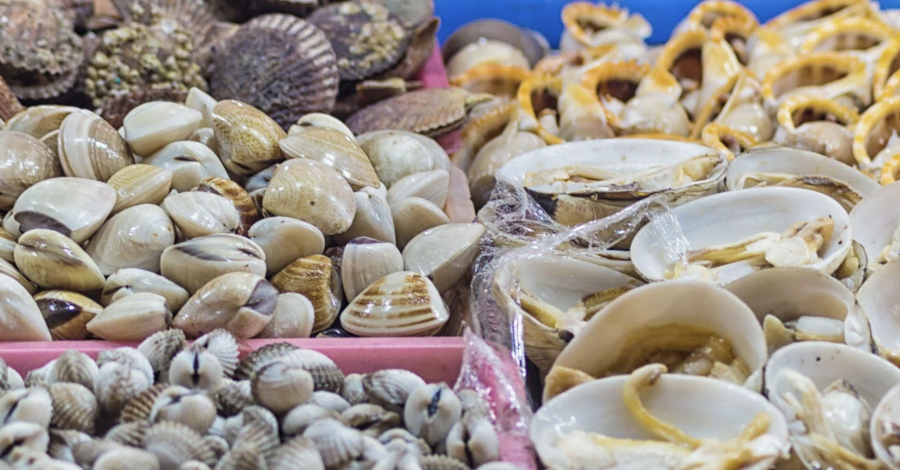(seafood.vasep.com.vn) Mollusks—an invertebrate aquatic animal group that includes clams, cockles, snails, oysters, abalone,... are one of the most promising sectors in Vietnam’s aquaculture industry and are playing an increasingly important role in the country’s marine economy. With ideal natural conditions and positive growth in both production and export value, mollusk farming is moving in the right direction. However, to ensure sustainable and effective development, several bottlenecks still need to be addressed.
Favorable Natural Conditions – The Foundation for the Mollusk Industry
Vietnam boasts over 3,260 km of coastline, more than 112 river estuaries, 660,000 hectares of tidal flats and an exclusive economic zone spanning over 1 million km². Numerous sheltered bays, lagoons, diverse seabed shelves and a tropical climate create a rich marine ecosystem -ideal for developing mollusk farming.
In 2024, the total mollusk farming area reached 57,000 hectares, a 5.5% increase compared to 2022, accounting for 90% of marine aquaculture area. Production hit 432,000 tons - equivalent to 56% of total marine aquaculture output - highlighting the growing significance of this sector. Export turnover was estimated at $200 million in 2024, a 70% surge from 2023, reflecting high market demand and strong development potential.
Seed production: Aquality revolution is needed
Currently, there are 635 mollusk seed production and nursery facilities across the country, but only about 23% of them have been certified as meeting the required conditions. Although artificial seed production has been successful for some species such as clams, oysters, abalone, blood cockles, geoducks, scallops..., the majority of seed sources still rely heavily on natural harvesting - especially clam seeds in Ben Tre and Tien Giang provinces.
Seed quality remains a major concern. Naturally sourced seeds show signs of degeneration and slow growth, which negatively impacts farming productivity. Meanwhile, although seed production technology has been transferred and applied in some localities, it remains fragmented, small in scale and has yet to establish a stable and professional seed production ecosystem.
Commercial Farming: Expansion without Uniformity
In 2024, commercial mollusk farming output reached nearly 478,000 tons, an 8% increase compared to the same period last year. Clams accounted for the largest share of this volume.
However, farming productivity varies significantly across regions. In Nam Dinh, yields range from 20 to 55 tons per hectare, while in Quang Binh, they reach only 2 to 8 tons per hectare. Stocking densities also differ greatly — the average is 25 individuals per square meter, but in some areas, it can reach up to 1,100 per square meter. High stocking densities prolong the farming cycle (sometimes up to 36 months), increasing the risk of disease outbreaks, especially during the seasonal transition from February to May.
Besides clams, other species such as oysters and pearl mussels are also being farmed but mostly using manual methods on a small scale with rudimentary technology and limited stability. The development of integrated farming models — such as combining babylon snails with seaweed, green mussels, or sea cucumbers — has helped diversify products, make more efficient use of water surfaces and reduce environmental risks.

Processing and export: A bright spot needing further support
Vietnam's mollusk processing industry has made significant strides. The range of products has become increasingly diverse and popular in the domestic market, including frozen boiled clams, half-shell clams, scallop adductor muscles, canned shellfish... Some products have also penetrated international markets.
According to Vietnam Customs data, in May 2025, exports of shelled mollusks (under HS codes 0307 & 16) reached $18 million, a 4% increase compared to May 2024. Cumulative exports of this product group in the first five months of 2025 reached $103 million, a 63% increase over the same period last year. Key export products include clams, snails and scallops with export values in the first five months of 2025 reaching $48 million (up 37%, accounting for 47%), $28 million (up 177%, accounting for 17%), and $21 million (up 133%, accounting for 20% of the total export value of this product group) respectively.
Significant Challenges on the Path to Development
Despite its great potential, Vietnam's mollusk industry faces numerous challenges: low seed quality and risks of degradation due to reliance on natural harvesting; high stocking densities leading to mass mortalities, disrupting planning and pressuring the environment; climate change impacts such as salinity fluctuations, rising temperatures, and water pollution that destabilize farming conditions; outdated, manual post-harvest technology resulting in low-quality products that are hard to sell; unstable consumer markets with fluctuating prices and unsustainable market channels; scientific research lagging behind practical needs, particularly in disease and environmental studies.
Future Direction: From “Doing More” to “Doing Effectively”
Vietnam’s aquaculture development strategy to 2030 positions the industry as “an important, modern, efficient and sustainable economic sector.” For mollusks, the targets are 480,000 tons by 2025 and 650,000 tons by 2030 with a focus on expanding offshore farming areas.
To achieve these goals, key measures include: re-planning farming zones with controlled area codes and licensing conditions; reorganizing production through cooperatives and enterprise linkages; supporting digitalization, traceability and logistics development; training farmers to shift from small-scale thinking to professional business models; advancing green economic models such as integrated and circular farming to improve resource efficiency.
Vietnam’s mollusk industry is now at a critical juncture. With natural advantages, traditional expertise and an expanding export market, the sector has the potential to become a cornerstone of Vietnam’s marine economy. However, achieving this requires a comprehensive, sustainable strategy with collaboration among the government, businesses and farmers. The future of Vietnam’s mollusk industry depends on how we overcome today’s challenges.